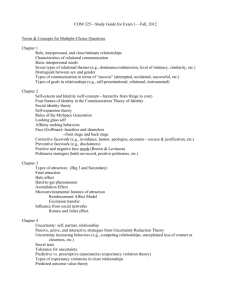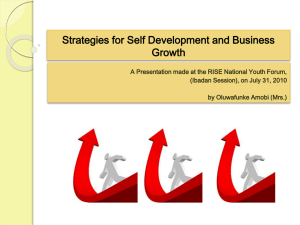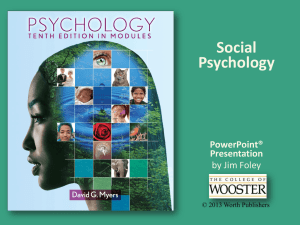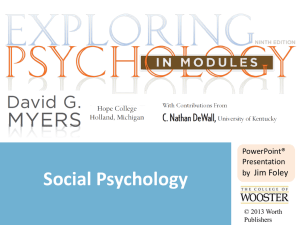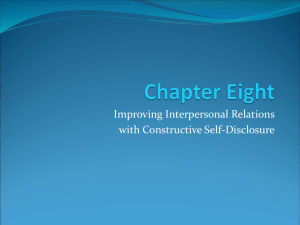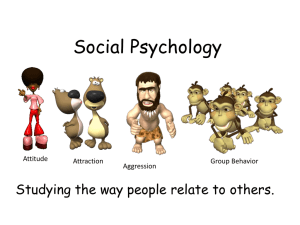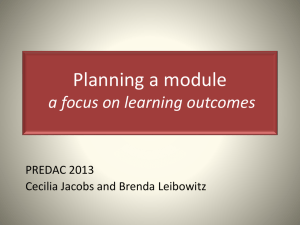Chapter 10 - Oxford University Press
advertisement
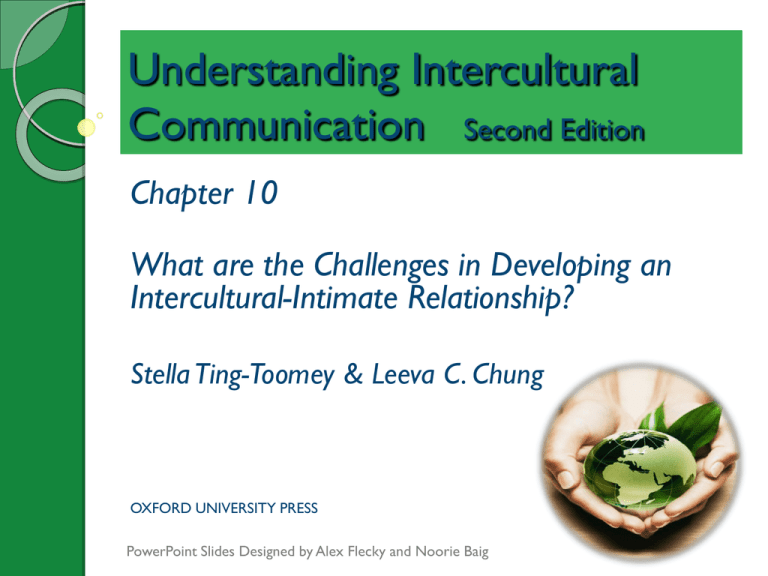
Understanding Intercultural Communication Second Edition Chapter 10 What are the Challenges in Developing an Intercultural-Intimate Relationship? Stella Ting-Toomey & Leeva C. Chung OXFORD UNIVERSITY PRESS PowerPoint Slides Designed by Alex Flecky and Noorie Baig TODAY’S MENU I. Developing Intercultural-Intimate Relationships: Invisible Challenges II. Intercultural-Intimate Relationship Attraction: Facilitating Factors III. Intercultural-Intimate Conflict: Obstacles and Stumbling Blocks IV. Raising Secure Bicultural Children V. Intercultural Reality Check: Do-Ables I. Developing Intercultural-Intimate Relationships: Invisible Challenges A. Cultural-Ethnic Membership Values Individualistic Orientation Collectivistic Orientation I-identity relationship expectations Couple’s privacy, autonomy Voluntary, personal commitment We-identity, ingroup relationship pressures Ingroup’s (we) connection, concerns Structural commitment, family and social reactions Low-context emotional expressions High-context emotional expressions “Fall in love,” passionate love Value companionate (friendship, loyalty) love Media Activity:YouTube Videos The Meaning of Love 7 Billion Others Church Bans Interracial Couple I. Developing Intercultural-Intimate Relationships: Invisible Challenges Discussion Questions: Intercultural-intimate relationships: Have you experienced a relationship of this type? What were some positive things that you gained from it? What were some negative things that occurred? What was most surprising to you about the different love expectations? Have you experienced the “me–we” dialectical forces in any of your relationships? What happened and how did you feel? II. Intercultural-Intimate Relationship Attraction: Facilitating Factors A. Perceived Physical Attractiveness Physical attractiveness critical to initial attraction; cultural differences regarding what is attractive. • For example, U.S. individuals attracted to: high energy, enthusiasm.; Korean individuals attracted to: high integrity, concern for others. B. Perceived Similarity • Similarity–attraction hypothesis: cognitive consistency • Intergroup–interpersonal attraction: attitudinal issues II. Intercultural-Intimate Relationship Attraction: Facilitating Factors C. Cross-Cultural Self-disclosure Comparisons • Self-disclosure: intentional process of revealing exclusive information about ourselves to others that other individuals do not know. • Social penetration theory: interpersonal information progresses from superficial nonintimate to more deep-layered intimate self-disclosure. • Shrek explains the onion metaphor of social penetration theory. II. Intercultural-Intimate Relationship Attraction: Facilitating Factors C. Cross-Cultural Self-disclosure Comparisons: Discussion Check out similarities and differences…. • Where did you learn your self-disclosure tendency? • Do you come from a high-disclosive family or a lowdisclosive family? • What topics do you consider as quite “Public”? • What topics do you consider as quite “Private”? II. Intercultural-Intimate Relationship Attraction: Facilitating Factors C. Cross-Cultural Self-disclosure Comparisons: Johari Window: II. Intercultural-Intimate Relationship Attraction: Facilitating Factors Media Activity: Fools Rush In film clip Discussion: • Can you relate to this clip? • How do the cultural value dimensions impact the development of your particular intimate relationship? • How did Alex and Isabel handle the dialectical tensions of autonomy and connectedness? • How did they differ in terms of disclosing to their parents about Isabel’s pregnancy? II. Intercultural-Intimate Relationship Attraction: Facilitating Factors D. Online Disclosure of Affection Do you stay in touch with your Facebook friends by “liking” their posts, photos, or statuses? E. Third-Party Matchmakers: Online and Mobile Dating Five phases of online dating: 1. Attention 2. Recognition 3. Interaction 4. Face-to-face meeting 5. Resolution II. Intercultural-Intimate Relationship Attraction: Facilitating Factors E. Third-Party Matchmakers: Online and Mobile Dating • Have you tried match.com or eharmony.com? How about pof.com (plenty of fish.com )? Take a look at this Indian matrimonial site: • Did you notice that his parents created this posting? How would you react if your parents did something like this out of concern for you? • What do you think of his complexion, caste, parents info, diet, and annual income?! II. Intercultural-Intimate Relationship Attraction: Facilitating Factors F. Intercultural/Interracial Romantic Relationship Development Interracial couples’ four stages of “racial” awareness and awakening: • • • • Racial awareness Coping Identity emergence Relationship maintenance II. Intercultural-Intimate Relationship Attraction: Facilitating Factors Some Intercultural-Intimate Relationship Research • Generation is predictor of interethnic relationships. • Individuals with assimilated, bicultural, or marginal identities have greater tendency to date outgroup members. • The “Romeo and Juliet” effect: The more the families are against relationship, the more the couple wants to rebel against parents, thus finding each other more attractive. III. Intercultural-Intimate Conflict: Obstacles and Stumbling Blocks A. The Encounter: Prejudice and Racism Intercultural-intimate conflict: Antagonistic friction or disagreement between two romantic partners caused, in part, by cultural or ethnic group membership differences. Have you observed prejudice or racism toward interracial couples? What occurred? III. Intercultural-Intimate Conflict: Obstacles and Stumbling Blocks B. Countering Racism and Prejudice: Coping Strategies: 1. Ignoring or dismissing 2. Normalizing 3. Withdrawing 4. Educating 5. Confrontation 6. Prayer 7. Humor IV. Raising Secure Bicultural Children A. Bicultural Identity Struggles: Four identity forms of bicultural children: 1. Majority-group identifiers 2. Minority-group identifiers 3. Synthesizers 4. Dissaffiliates IV. Raising Secure Bicultural Children: Some suggestions: Work out identity plan early – communicate with your partner (e.g., religious faith, language, customs). • Listen to your children’s identity experiences. • Provide cultural enrichment opportunities. • Be truthful about prejudice & racism issues. • Nurture & support different identity facets. • Provide safety net & maturation challenges. Realize that children will grow up & choose their own identity path…. • Together: DRAW an ideal dream house…. • IV. Raising Secure Bicultural Children B. Cultivating a Secure Multifaceted Identity To help bicultural individuals: • Know values and beliefs of each group. • Positive attitude toward both groups. • Confidence that one can live effectively within both groups without compromising one’s individual identity. • Be grounded. V. Intercultural Reality Check: Do-Ables In managing diverse intimate relationship issues, here are some helpful do-ables: • Pay attention to culture-based challenges. • Be mindful that individualists and collectivists may hold different expectations. • Be sensitive to your partner’s family reaction issues. • Be flexible in learning your partner’s communication styles. Parting Thoughts… Living on borders and in margins, keeping intact one’s shifting and multiple identity and integrity, is like trying to swim in a new element, an “alien” element. ~ Gloria Anzaldua
